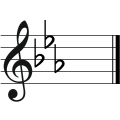E-flat major
E-flat major is a key of the major family, based on the root E-flat. The key of E-flat major is written in musical notation with three ♭ (b, e-flat, a-flat). The corresponding scale and the fundamental chord of this key (the tonic E-flat-g-b) are also designated by the term E-flat major.

![]()
![]()
![]()
![]()
![]()
![]()
![]()
![]()
![]()
![]()
![]()
![]()
![]()
![]()
![]()
E-flat major is often perceived as warm and less bright than the major keys with cross accidentals, but see the article Key Character.
Many pieces for wind instruments are in E-flat major, since instrumentalists with brass instruments in B-flat, clarinets in B-flat and horns in F must then play with fewer accidentals.
Key classification
| Keys and their accidentals | |||||||||||||||
| Portent: | 7 ♭ | 6 ♭ | 5 ♭ | 4 ♭ | 3 ♭ | 2 ♭ | 1 ♭ | 0 ♭/♯ | 1 ♯ | 2 ♯ | 3 ♯ | 4 ♯ | 5 ♯ | 6 ♯ | 7 ♯ |
| Major keys: | Ces | Ges | Des | As | It | B | F | C | G | D | A | E | H | F# | C sharp |
| Minor keys: | as | it | b | f | c | g | d | a | e | h | F# | cis | gis | dis | ais |
Questions and Answers
Q: What is E♭ major?
A: E♭ major is a musical major scale starting on the note E♭.
Q: How many flats are in its key signature?
A: Its key signature has three flats.
Q: What is the relative major of E♭ major?
A: The relative major of E♭ major is C minor.
Q: What is the parallel minor of E♭ major?
A: The parallel minor of E♭ major is E♭ minor.
Q: Is there any difference between a relative and a parallel minor?
A: Yes, a relative minor refers to the sixth degree of the parent scale, while a parallel minor refers to playing the same notes as its parent scale but beginning from its third degree.
Q: Can you give an example of another musical scale with three flats in its key signature?
A: Bb Major has three flats in its key signature.
Search within the encyclopedia














